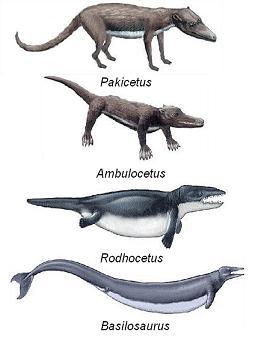
Extinct predecessors of modern whales. Small changes over time adapted the now extinct land mammal Pakicetus to life in water. Over time these changes made it more whale-like.
If an existing species is separated into two groups living in different environments, then the groups will evolve differently from each other, since different mutations will suit different environments. Eventually the two groups will become so different that they cannot interbreed. They are now two separate species.
Evolution by natural selection proceeds slowly and in very small steps. Each incremental change must be beneficial to the organism in order for it to be selected. Very big mutations are likely to be disadvantageous to the organism, so they are rare. This is reflected in the fossil record, where we can track the very small changes over time.[1]
Although natural selection allows only small improvements in each generation, over millions of years these can build up into big changes, such as the evolution of whales from land mammals or snakes from reptiles. Indeed, the evolution of all the variety of life on Earth has taken many hundreds of millions of years. This story will be explored in further slideshows.
It can sometimes seem as if evolution is working it's way towards a goal. But there is no planning or sense of the future in natural selection. It only works one step at a time. It works with what it inherits. It cannot rebuild entire structures, it must modify and tinker with what it has. Thus parts of the body can be co-opted for functions which are very far from their original purpose.

Mammalian and non-mammalian jaws. In the mammal configuration, the quadrate and articular bones are much smaller and form part of the middle ear. Note that in mammals the lower jaw consists of only the dentary bone.
For example in mammals, bones that were part of the jaws of their predecessors were co-opted into the inner ear, see Wikipedia: Evolution of mammalian auditory ossicles.
Consider also the eye. If you sat down and designed it, it would look very different. But it has its evolutionary history written all over it.
An advantageous variation can also remove "features" of an organism. For example cavefish, which evolved from normal sighted fish, have lost their eyes altogether. Cavefish don't need to see in the darkness of a cave, and the energy it takes to build and maintain an unnecessary eye is a disadvantage, so the eye is selected against. There are indications that this process took as little as 10,000 years. (reference?) Many cave-dwelling animals (Wikipedia: Troglobite) have also lost the pigment in their skin for similar reasons.
Author: Tom Brown
Copyright: public domain
Date last modified: 13th Oct 2011
Peer-review status: Not yet peer-reviewed
whale evolution: source: http://www.dolphin-way.com/dolphins-%E2%80%93-the-facts/evolution/, copyright: unknown
mammal jaw evolution: source: Wikipedia, copyright: public domain